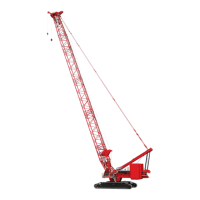UNDERCARRIAGE MLC80A-1/MLC90A-1/MLC100A-1/MLC100-1 SERVICE/MAINTENANCE MANUAL
8-2
Published 10-09-2020, Control # 259-06
The reduced hydraulic pressure allows spring force to apply
the travel brakes.
Travel 2-Speed Operation
The travel motors are variable displacement and shift
internally with an adjustable spring in each motor P/C
(Pressure Compensator) valve that is preset at 270 bar
(3,915 psi). The travel speed switch allows the operator to
select low speed when smoother starts and precise control
over the load is required or high speed when maximum
available travel speed is required.
When the 2-speed switch is in the low position, the control
system sends an output signal to enable the travel speed
solenoid. The valve shifts to direct accessory pressure to the
end of the P/C valve. The P/C valve shifts the PCOR spool
placing the travel motors in maximum displacement (high
torque, low speed). The travel motors remain in this position
until the 2-speed switch is placed in the high position and
engine speed is more than 1350 rpm.
When the 2-speed switch is in the high position, the travel
motors remain in minimum displacement (low torque, high-
speed) when starting. If system pressure rises to 270 bar
(3915 psi) when the crawlers begin to move, the P/C will shift
toward maximum displacement, as required up to max
displacement, to maintain 270 bar (3915 psi) so that
maximum tractive effort is always available.
The travel motors shift back to minimum displacement
automatically if engine speed is above 1350 rpm and system
pressure is below 270 bar (3,915 psi). If engine speed is
below 1350 rpm, the travel speed solenoid is enabled even if
the 2-speed switch in the high position. The travel speed
solenoid is disabled, shifting the valve, and accessory
pressure to end of the P/C valve. This action allows the
motor to operate in the PCOR mode.
Travel Cruise Operation
The travel cruise switch on the left travel handle allows the
crawlers to operate in either direction at a selected speed
without manually moving the travel handles. Once moving in
the desired direction and speed, press and release the
cruise switch. The control system locks-in the travel
information and the travel direction and speed are
maintained when the travel handles are released to the
neutral position.
Pressing and releasing the switch again or moving either
travel handle in the opposite direction from neutral, opens
the travel cruise circuit and returns control of the crawlers to
the operator.
Forward Travel Operation
To enable the travel control system, the switches listed
below must be in the stated positions:
• Seat safety switch closed
• Travel park switch in the UN-PARK position
When either control handle is moved to the forward position,
the joystick (J2) communicates the travel command to the
CCS.
At the same time, the CCS communicates the forward travel
command to the solenoid at the corresponding proportional
control valve.
• If the left control handle is moved forward, the CCS
energizes the left travel proportional control valve,
shifting the valve to the position that allows hydraulic oil
from Pump A to flow to the left travel motor for forward
travel.
• If the right control handle is moved forward, the CCS
energizes the right travel proportional control valve,
shifting the valve to the position that allows hydraulic oil
from Pump B to flow to the right travel motor for forward
travel.
• Simultaneously, the travel brakes are released to allow
travel.
The following sensors provide feedback to the CCS:
• Pump A and Pump B pressure sensors
• Left travel pressure sensor
• Right travel pressure sensor
The control system uses this feedback to adjust the pump
and motor flows to maintain the speeds commanded by the
handles.
Reverse Travel Operation
To enable the travel control system, the switches listed
below must be in the stated positions:
• Seat safety switch closed
• Travel park switch in the UN-PARK position
When either control handle is moved to the rearward
position, the joystick (J2) communicates the travel command
to the CCS.
At the same time, the CCS communicates the reverse travel
command to the solenoid at the corresponding proportional
control valve.
• If the left control handle is moved rearward, the CCS
energizes the left travel proportional control valve,
shifting the valve to the position that allows hydraulic oil
from Pump A to flow to the left travel motor for reverse
travel.
• If the right joystick handle is moved rearward, the CCS
energizes the right travel proportional control valve,
shifting the valve to the position that allows hydraulic oil
from Pump B to flow to the right travel motor for reverse
travel.

